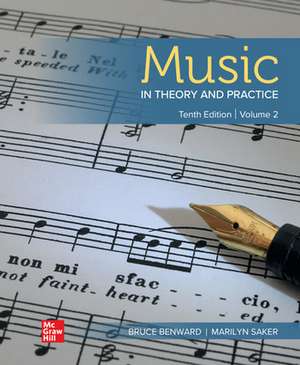Music in Theory and Practice Volume 2
Autor Bruce Benward, Marilyn Sakeren Limba Engleză Paperback – 25 mar 2020
The two-volume format ensures exhaustive coverage and maximum support for students and faculty alike. Volume I serves as a general introduction to music theory while Volume II offers a survey of the theoretical underpinnings of musical styles and forms from Gregorian Chant through the present day. The supplemental instructor's materials provide clear-cut solutions to assignment materials. Music in Theory and Practice is a well-rounded program that integrates the various components of musical structure and makes them accessible to students at the undergraduate level.
Resources available from the Connect Online Learning Center include printable versions of the Instructor’s Manuals and Workbook Solutions Manuals, audio files, assignment templates compatible with Finale® Music Notation software, supplementary drill assignments, testing materials, and recordings. Audio files available for this edition of Music in Theory and Practice are identified throughout the texts and workbooks with the ♫ graphic.
Preț: 1090.68 lei
Preț vechi: 1198.54 lei
-9% Nou
Puncte Express: 1636
Preț estimativ în valută:
208.71€ • 215.64$ • 173.62£
208.71€ • 215.64$ • 173.62£
Carte tipărită la comandă
Livrare economică 19 martie-02 aprilie
Preluare comenzi: 021 569.72.76
Specificații
ISBN-13: 9781260493559
ISBN-10: 1260493555
Pagini: 400
Dimensiuni: 234 x 279 x 25 mm
Greutate: 0.86 kg
Ediția:10
Editura: McGraw Hill Education
Colecția McGraw-Hill
Locul publicării:United States
ISBN-10: 1260493555
Pagini: 400
Dimensiuni: 234 x 279 x 25 mm
Greutate: 0.86 kg
Ediția:10
Editura: McGraw Hill Education
Colecția McGraw-Hill
Locul publicării:United States
Cuprins
Preface
Part C: The Renaissance And Baroque Periods
Chp. 18: Late Renaissance Polyphony
Chp. 19: Two-Voice Eighteenth Century Counterpoint
Chp. 20: The Fugue
Part D: Chromatic Harmony
Chp. 21: Borrowed Chords
Chp. 22: Neapolitan 6th Chords
Chp. 23: Augmented 6th Chords
Part E: The Classical Period
Chp. 24: Variation Technique
Chp. 25: Sonata Form
Chp. 26: Rondo Forms
Part F: Extended And Chromatic Harmony
Chp. 27: 9th,11th, and 13th Chords
Chp. 28: Altered Dominants
Chp. 29: Chromatic Mediants
Part G: The Nineteenth And Twentieth Centuries
Chp. 30: The Romantic Period
Chp. 31: The Post-Romantic Style
Chp. 32: Impressionism and Related Styles
Chp. 33: The Early Twentieth Century
Chp. 34: Pitch-Class Set Theory
Chp. 35: Twelve-Tone Technique
Postlude: Music Since 1945
Appendix G Summary of Part-Writing Practices
Appendix H Macro Analysis Symbols
Appendix I Popular Music Chord Symbols
Glossary
Credits
Index
Part C: The Renaissance And Baroque Periods
Chp. 18: Late Renaissance Polyphony
Chp. 19: Two-Voice Eighteenth Century Counterpoint
Chp. 20: The Fugue
Part D: Chromatic Harmony
Chp. 21: Borrowed Chords
Chp. 22: Neapolitan 6th Chords
Chp. 23: Augmented 6th Chords
Part E: The Classical Period
Chp. 24: Variation Technique
Chp. 25: Sonata Form
Chp. 26: Rondo Forms
Part F: Extended And Chromatic Harmony
Chp. 27: 9th,11th, and 13th Chords
Chp. 28: Altered Dominants
Chp. 29: Chromatic Mediants
Part G: The Nineteenth And Twentieth Centuries
Chp. 30: The Romantic Period
Chp. 31: The Post-Romantic Style
Chp. 32: Impressionism and Related Styles
Chp. 33: The Early Twentieth Century
Chp. 34: Pitch-Class Set Theory
Chp. 35: Twelve-Tone Technique
Postlude: Music Since 1945
Appendix G Summary of Part-Writing Practices
Appendix H Macro Analysis Symbols
Appendix I Popular Music Chord Symbols
Glossary
Credits
Index
